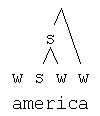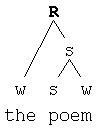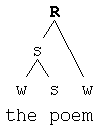3.2 - Some Prosodic Rules
3.2.1 - Words
The stress or prominence given to a certain syllable is usually dependent on pitch, duration or length, and amplitude or loudness. Of these pitch is the most important but all of them act as intensifying features. Syntactically speaking, words are either content words or function words. "Content words are words which operate with a certain degree of independence, conveying a full meaning by themselves. They are nouns, verbs, adjectives and adverbs. Most of the words in the dictionary are content words. Function words are words that depend on other words for their meaning, usually indicating some kind of relation. They include prepositions, articles, demonstratives, conjunctions, pronouns, and auxiliaries" (PR 27-28).
3.2.2 - Using Tree Structures to Understand Stress
Most monosyllabic (single syllable) content words have a stress (e.g., clock, red, run). Simple polysyllabic (more than one syllable) words may have only one stress, e.g., rabbit, but more complicated words may have more than one stress. Since stress is both relative and hierarchical, one of the most persuasive ways of both understanding and representing stress in such words is through what is called tree notation. Adopted from GENERATIVE LINGUISTICS, especially the work of Liberman (1975) and Kiparsky (1977), trees can be used to represent not only the stress of individual words but their relationship with one another in phrases and among larger units of the poem.
Begin by assigning LEXICAL STRESS to the syllables of every word, using an "s" for strong syllables and a "w" for weak ones, as in
s w rabbit
Every syllable, as labeled with an s or a w is called a "terminal node" because each syllable is an endpoint or non-branching terminus within the tree structure. The tree structure for "rabbit" looks as follows:
(3)

An "R" at the top of the tree indicates that the tree is rooted, meaning that it comprises a single constituent at its highest level. This notational system, using s's and w's with tree structures, applies throughout in binary pairings. Hence, there may be no w or s in isolation, and every s must be connected to a w and every w to an s. Likewise, all intermediate levels of branching must be connected in pairwise fashion until the single "root" (the topmost R) is reached, which signals that the linguistic material under analysis has been exhausted.
Assign s's and w's and the appropriate tree structure to the following words: arrive, crystal, freedom, exam.
In order to build up the tree structure for words with more than two syllables, a higher level of tree structure is required. The tree structure is built up by working leftward from the end of the word, stopping at each s to connect it with a w on its right. I illustrate the steps to be taken with the word "america."
(4)
a. First assign w's and s's:

b. Working from the end of the word leftward, stop at the first s and construct a branched node connecting the s with the first w on its right:

c. The first branched node over "-meri-" is now connected by a higher branched node with the "-a-" on its right. Since "-a-" is weak (w), and "-meri-" contains an s at its first level, "-meri-" is assigned an s, showing its relative strength.

d. Finally, construct a still higher branched node to connect the leftmost stranded w with the s material on its right. Place an R at the top to show that the tree is rooted, that all the material under analysis has been exhausted.

In stress trees the strongest stress in any word may be traced to the syllable dominated by s's all the way up the tree; in this case, that syllable is "-mer-."You may wonder why these rules for constructing branched nodes must apply in the way I have demonstrated above. Why does it matter how any w is connected to an s or vice versa? Tree structures, when properly applied, show both the relative and the hierarchical nature of stress. The degree of stress a syllable receives is determined by its stress context. It is "not absolute but exists by virtue of the greater or lesser stresses next to it" (Kiparsky, "The Rhythmic Structure of English Verse" 194). By mirroring the syntactic structure of a word, phrase or line, the tree structures also show the progressive levels or the hierarchy of stress. The rules we are using here to show the relative nature of stress in words will be applied again at larger and larger levels of the poem, allowing us to understand more readily the phrasal rhythms of much English poetry. To show you an example of how the rules for assigning s's and w's and their tree branches matter, it helps to consider a unit larger than a single word, for example, the phrase, "the poem." Here are the steps in its analysis.
(5)
a. Assigning w's and s's, we have:

b. The question now is: How is the tree structure to be built up? Since an important rule of this notation is that branching must preserve the internal structure of every word in the phrase, the notation must be:

c. This structure-preserving constraint on branching rules out the alternative which would break the word boundary between "the" and "poem" (here and elsewhere mistaken examples are indicated with an asterisk):
* 
The incorrect scansion in example (5c) does not mirror syntactic structure as example (5b) does and it incorrectly represents the relative nature of stress by suggesting that there is a more major stress contrast between "po-" and "-em" than between "the" and "po-," which involves the setting-off effect of a word boundary. The connection between syntax and rhythm which the stress tree system of analysis highlights is of inestimable importance in determining how and where a poet exploits the tensions between these aspects of language as well as the impact of these tensions on the semantic level.
Assign w's and s's and their appropriate tree structures to the following: linguistics, gratitude, amazing, the pony, a flashlight, photograph.